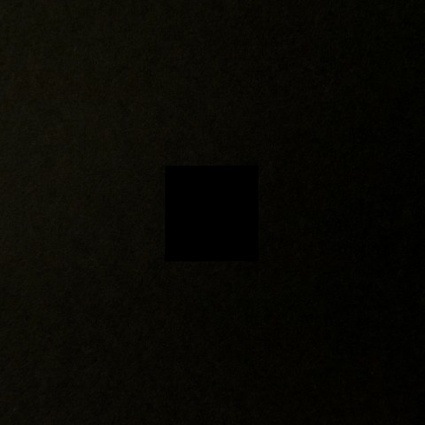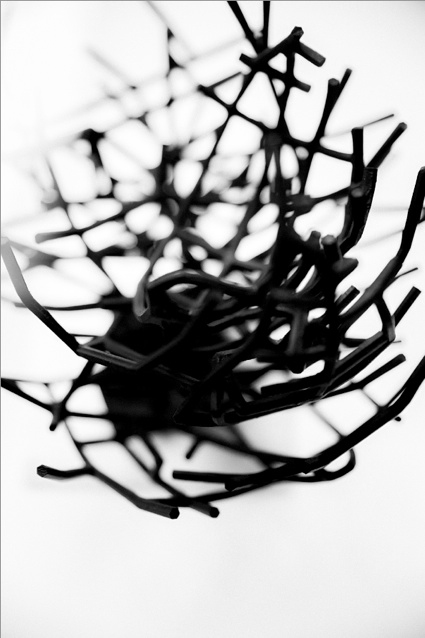 M1NE#1
M1NE#1
It would be convenient but unfair to reduce the work of Frederik de Wilde to its award-winning ultra dark, nano-engineered black painting. Just like Yves Klein collaborated with chemists to create the now iconic International Klein Blue, de Wilde worked with scientists in both Europe and the U.S.A. to nano engineer a material so dark that it absorbs all visible light as well as some invisible like infrared light. Quite aptly, the artwork is called Hostage.
De Wilde further expanded his research into spectral behaviour and innovation at the atomic level with M1NE #1, a 3D sculpture so dark that it appears as if it were devoid of any volume. The artwork translates classified data gathered from Belgian coal mines into a structure that hides political dossiers and possibly commercial interests into abstract forms.
Frederik de Wilde in collaboration with Frederik Vanhoutte, SoN01R 1.0
In fact, de Wilde’s investigations don’t stop at nanotechnology, he also explores biotechnology, data networks, or any other scientific fields of research in order to uncover new frontiers of the intangible, inaudible, invisible. I was particularly intrigued by SoN01R for example. The work is a real-time visualization of true random numbers generated from a quantum mechanical system.
All of the above might sound abstract and highly conceptual but as the interview with the artist will demonstrate research into elusive energy measurements and other barely perceptible phenomena quickly gives rise to reflections about politics, art history, economic emergency, universe hacking and very practical innovations in ‘clean’ energy.
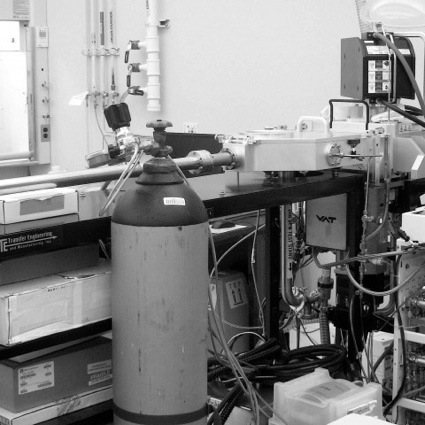 Nano Painting, Rice University Nano Lab, 2010
Nano Painting, Rice University Nano Lab, 2010
Hi Frederik! What makes nanotechnology a valuable field of experimentation for an artist?
Let’s debunk some myths first. Nanotechnology is not new on itself. The Mayans used nano particles in their pottery, the Romans in glass, and so on. A great example is the Lycurgus cup made from translucent glass containing colloidal gold and silver particles dispersed in the glass matrix in certain proportions so that the glass has the property of displaying a particular transmitted colour and a completely different reflected colour, as certain wavelengths of light either pass through or are reflected. This is called surface plasmon resonance where photons interact with electrons. It’s like a dance on subatomic level. It connects colour theorists like Da Vinci with Isaac Newton, Cézanne, Kandinsky, …
In my case i most interested in creating a black body, an idealised body that absorbs all incident electromagnetic radiation, regardless of frequency or angle of incidence. The first artistic result was the artwork entitled “Hostage p.t.1″ which won the Ars Electronica Next Idea Grant in 2010.
What changed dramatically is the level of control in the nano tech praxis. It’s unprecedented and still evolving rapidly. Let’s take a step back into time to make things more clear.
One of the seminal events in the history of nanotechnology is -ever jittery- physicist Richard Feynman‘s lecture entitled “There’s Plenty of Room at the Bottom” at Caltech on December 29, 1959. Feynman considered the possibility of direct manipulation of individual atoms as a more powerful form of synthetic chemistry than those used at the time. Let’s not forget John Von Neumann, one of the founding figures in computer science, concept of the universal constructor in his theoretical and mathematical frameworks of self-replication. This clearly inspired Feynman to suggest the possibility of self-replication from atomic level onwards.
The concept led also to dystopian projections and hypothetical end-of-the-world scenarios, out-of-control self-replication (nano-)robots consuming all matter on Earth leaving nothing but a ”gray goo”, a term coined by nanotechnology pioneer Eric Drexler in his book Engines of Creation (1986).
As an artist i am not only interested in the history of science -or connecting it to an art historical perspective, a source of inspiration, a practical tool, the technological innovation potential, and so on …, but also, and this has been less exposed until now, from a societal point-of-view. We are in a time of fundamental transition(-s), great turbulence, … our contemporary society (read also ‘old’ world) is crumbling, it’s fundaments are shaking profoundly.
Nanotechnology offers me a context to reflect upon the idea of building up a society anew from scratch -or ‘personalise’ it by the level of individual control-, atom by atom sort of speaking ((I am well aware that we’ve heard this story before (e.g. Futurist Manifesto ;), but where governments currently overload us with rules, regulations and restrictions we should bend it to possibilities, personalisation, et al. If not anticipated in the future we’ll be confronted with a higher frequency of massive upheavals, strikes, civil unrest and revolts. This time from the proletarians AND the middle class. That’s the 99%.
Multinationals and corporations have the leverage to make governments change their agenda, but they won’t as long as there is no economic urgency and clear business model. This model will need to grow from inside and from the bottom of the pyramid. This will take time but one can see this slowly happening.
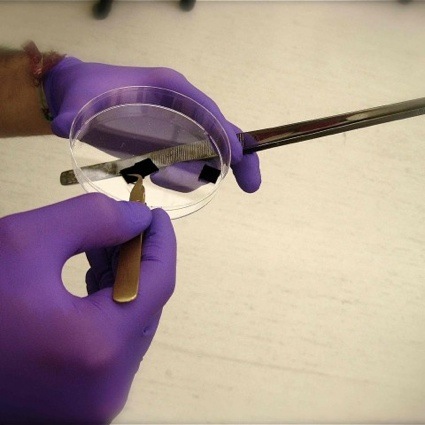 Nano Painting, Nano Black Material
Nano Painting, Nano Black Material
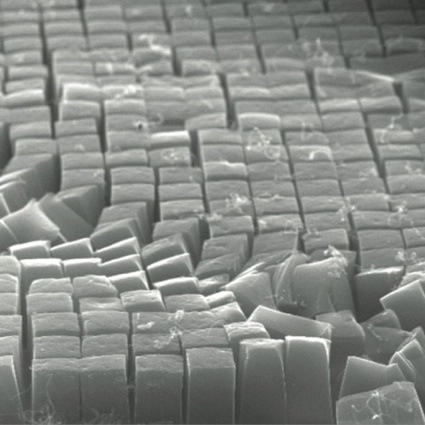 Nano Painting, Scanning Electron Microscope Image _ Nano Black Material
Nano Painting, Scanning Electron Microscope Image _ Nano Black Material
But what’s in it for the scientists you collaborated with (i read you worked with NASA, the University of Hasselt and Rice University)? What made your research into ultra black valuable for them?
It’s layered. Most valuable is bringing together a group of passionate inter- and transdisciplinary individuals. As an artist you are a free electron. I don’t have to align myself so easily with rules and regulations, institutes, … i can be ‘wild’ and that’s a quality that is generally accepted and respected. This stimulates and facilitates cross linking, confrontations with different ways of seeing, other ways of experimentation, getting out of the comfort zone.
In the case of the Nano Black research it depends. Currently i am challenging my collaborators at NASA to grow CNT‘s on a three dimensional matrix, which is not easy to accomplish. The concrete result of this first experiment in this direction is M1NE#1. The sculpture is made by direct laser sintering of micro particles titanium. The artwork is based on highly sensitive (political and economic) data of the coal mines in Belgium, seven mines in total. After a half a year of lobbying, and signing documents, i finally achieved to get a hold of the data. The main restriction was not to represent the actual data but only ‘subjective’ data, whether it’s a sculpture, painting didn’t matter.
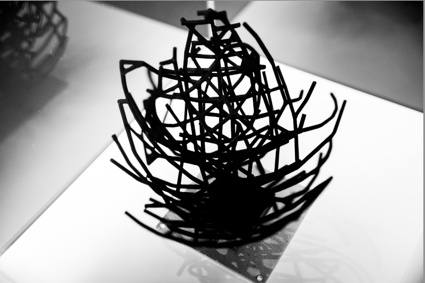 M1NE#1
M1NE#1
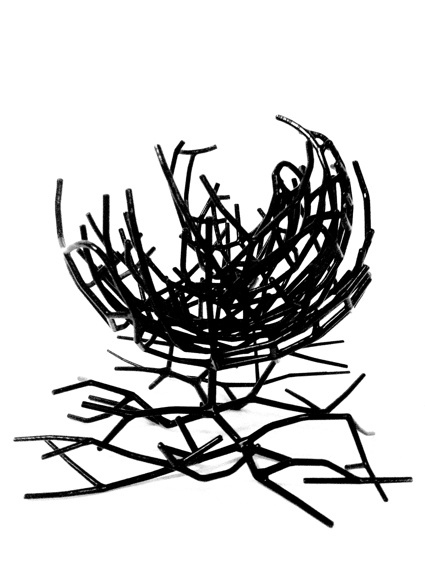 M1NE#2
M1NE#2
This said; it’s all about challenging, maintaining and accelerating dynamics, growing connections: stimulating growth. Maybe i am also used as an excuse for failure, haha :).
Whereas the scientific world is still too much compartmented, an artist can add a more personal, holistic, … approach. I am interested in models, whether it’s mathematics, art, society, … it doesn’t really matter. That’s the bigger picture i am interested in and scientists are very eager to discuss these matters but preferably in a well defined -and controlled- context. I think that’s a pity, and also scientist should participate more in societal issues. It’s one of my ambition to create more space for this issue by the means of setting up art, science and technology projects. This is a gradual process. Most of the time it ends up with a demonstrator but that’s not enough for me. The next step is deduct or grow a model from it with a deeper impact on more societal levels and give it a shape.
I also read about potential industrial applications: photovoltaic systems, invisible airplanes (oh, please no!), telescopes coating, etc. Do you want to give more details about it?
When you have a material that absorbs all visible light, and even some spectra of the invisible light like infrared and UV light, it’s logical to think about photovoltaic cells. If one can improve the efficiency of a solar panel then that’s a real good thing. Participating in the clean energy discourse makes me feel good, having potential solutions imbedded in an artistic and crossover project is even better. Making objects ‘invisible’ or three dimensional objects appear flat like a cutout, augmenting a canvas or substrate, a three dimensional matrix or sculpture with an enhanced topography or nano coating that can act as a photovoltaic cell is certainly interesting from artistic, scientific and industrial applications point-of-view. Innovation thrives not only on single innovations but also combining and recombining ideas, techniques and technologies.
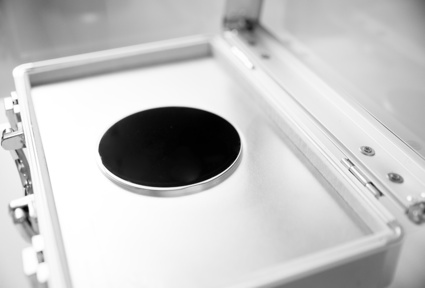 Frederik de Wilde, NASABlck-Crcl #1, 2013
Frederik de Wilde, NASABlck-Crcl #1, 2013
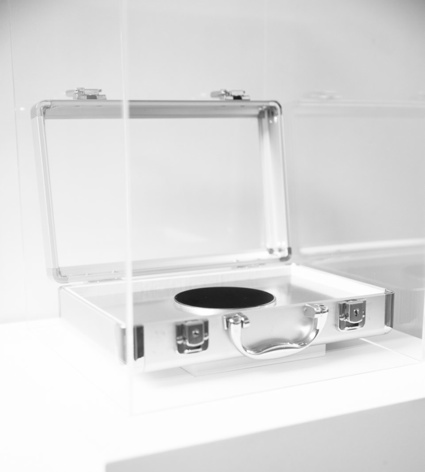 Frederik de Wilde, NASABlck-Crcl #1, 2013
Frederik de Wilde, NASABlck-Crcl #1, 2013
The artwork entitled ”NASABlck-Crcl #1” makes clear reference to Duchamp’s readymades.
It’s the most complete black body to date only applied in one telescope in space. This allows for less stray light which results in a sharper image. Yes, it would make a very good camera obscura.
The projects Quantum Objects, Quantum Foam and SoN01R explore true random numbers. Can you briefly explain what these true random numbers are? And what drew you to randomness?
Generating true random numbers is rather exceptional. Most random number generators are based on computer algorithms. Once the input conditions are known, one can reverse-engineer such algorithms which suggests a reproducible outcome. To be able to generate truly random numbers one would need a routine that can break the causality law, an observation of a source that acts without any or any knowable cause.
I’ve always been interested in the concept and notions of ‘noise’, again from different points-of-view (astrophysics, music, art, mathematics, societal, …). The installation αTown #Lead Angels 1.0 is a fine example. Here i use uranium glass aka vaseline glass or Great Depression glass as a source for generation true random numbers. In the case of Quantum Objects, Quantum Foam and SoN01R i use quantum vacuum noise to generate true random numbers. It’s hacking, or tuning into, the substrate of the universe.
αTown #Lead Angels 1.0
Reliable and unbiased random numbers are needed for a range of applications spanning from numerical modelling to cryptographic communications. It use will become more and more important in our contemporary society. For instance equations used at stock markets like the Black-Scholes equation should incorporate more noise, more randomness. That’s why i developed the idea of social algorithms. Currently i am collaborating with Post-doctoral researcher Vincenzo De Florio to develop an art and science project that will demonstrate the application of such an algorithm. For the record; i am not a scientist or mathematician, but i do my best in trying to understand the big picture and specificities related to a certain research topic.
![0Quantum Foam #2 [sphere] - Red Edition.jpg](https://we-make-money-not-art.com/wow/0Quantum%20Foam%20%232%20%5Bsphere%5D%20-%20Red%20Edition.jpg) Quantum Foam #2 [sphere] – Red Edition
Quantum Foam #2 [sphere] – Red Edition
![0Quantum Foam #2 [sphere] - White Edition.jpg](https://we-make-money-not-art.com/wow/0Quantum%20Foam%20%232%20%5Bsphere%5D%20-%20White%20Edition.jpg) Quantum Foam #2 [sphere] – White Edition
Quantum Foam #2 [sphere] – White Edition
How did you go from exploring the super small to investigating the vacuum? Was it something logical for you?
I guess by getting lost, and connecting the pieces step-by-step. It’s intuitive as much as logical.
One of my main sources of inspiration is the ‘Powers of Ten’ (1977), a cinematic scientific film essay by Charles and Ray Eames. In short; a set of pictures of two picnickers in a park, with the area of each frame one-tenth the size of the one before. Starting from a view of the entire known universe, the camera gradually zooms in until we are viewing the subatomic particles on a man’s hand. I am trying to insert a less materialistic point-of-view in science by the means of art. It’s not that i have a perfect marriage with science :)
Powers of Ten, 1977
You’ve collaborated with various research departments in universities across Europe and the United States. Which form did the collaboration take? Was this you bringing the ideas, explaining scientists exactly what you wanted them to achieve for you and then they worked in their lab behind closed door? Or do you, in some way, take a more active role in the lab processes?
Collaboration is a format, a template but at finer resolution it can take many shapes. I see also similarities but also differences in approach depending on the country etc. Sometimes it’s a question, an idea or an image that pops up in my mind when confronted with scientific research that i resonate with. The next step is to get in contact with the scientist and pose your question, communicate your idea. Generally I include some reference projects so the scientist has a better idea of your approach, potential outcomes, …but most of all that you are able to bridge the gap between art and science. This is crucial. You have to do your research and do your hours :)
In the best case i am invited for a residency, this enables me to stay for a longer time, get to know the people, daily routines but most of all getting hands on experiences and go deeper into the subject. You have to be in an ecology to understand it, get a feel of it. Blowing things up is a part of that too ;). This reminds me of Jean-Jacques Cousteau whom was asked in an interview why he blew up a part of coral reef when he was young. He answered that it was the only way to understand how a coral reef regenerates. Anyway, i wanted to produce the blackest artwork in the universe and i knew that Rice was and is the heimat of nanotechnology. In the case of developing the ”Hostage p.t.1″ i went to Rice University in Texas Houston several times and collaborated with Prof. Pulickel, Robert and Daniel in the chemistry lab. They were already researching CNT’s so that was a perfect match. Sometimes you have to be lucky too. The next step was to grow the array of vertical aligned CNT’s uniformly and on a large enough substrate. The latter is very difficult as the ion sputtering rooms and chemical vapour depositing don’t allow large samples. So for that time being we focused on creating a mosaic and going as black as we could. It’s obvious that initially i was not allowed to be in the lab alone, hence i was accompanied by Daniel, a very promising scientist and entrepreneur, to help me out.
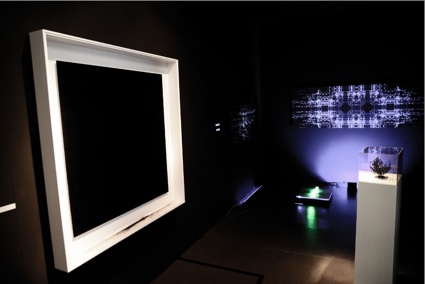 UNPAINTED art fair 2014 booth view
UNPAINTED art fair 2014 booth view
Ultimately i’m amazed at how brave you are to tackle such complex scientific fields. Science today seems to get increasingly compartmentalized with researchers specializing in various sub-disciplines. How can an artist approach these intimidating scientific fields? Is there a steep learning curve?
Forget being an artist, or pretend to be one. Be a person that is very interested in what the scientists do, be curious, make semantic connections, share you thoughts, ideas and feelings.
The more open you are the more chance you have to find like-minded people, they will help and guide you through topics that are hard to wrap your brain around. Sometimes making a sketch or drawing of the topic helps a lot. Knowing your limits is very important too.
I’m quite familiar with art and science initiatives, commissions, programmes and funding organizations in the UK but i know very little of what is at the disposal of an artist living in other European countries and wanting to work with scientists. What exists in Belgium where you live for example? Is this common for an artist to find funding and opportunities to work with research institutes?
Unfortunately our ministry of culture doesn’t support yet artistic crossover with research and development. Which is a real pity. As the financial envelope for the arts becomes smaller and smaller i notice some conservative tendencies. That is very corrosive for the arts, which thrives on the niche, and is maybe a niche on itself. Stigmatising it is like stigmatising art itself. To come back to your questions; generally I am invited by a University, sometimes I co-invest myself to make the project and collaboration possible. With the University of Hasselt (UH) i have a long term commitment, this is often due to long term friendships like with Prof. Jean Manca from the UH. Currently i am also involved in some EU funded projects, most of them have a crossover DNA. Funny enough the initiative for crossover projects isn’t an arts initiative but an initiative from the ministry of innovation, science and technology and Flanders DC. It’s called CiCi and supports crossover projects.
More info here: http://www.flandersdc.be/en/cici-call
Also iMINDS offers an ART&D call.
More info here: http://www.iminds.be/en/research/start-a-project/artd-program
Thanks Frederik!

